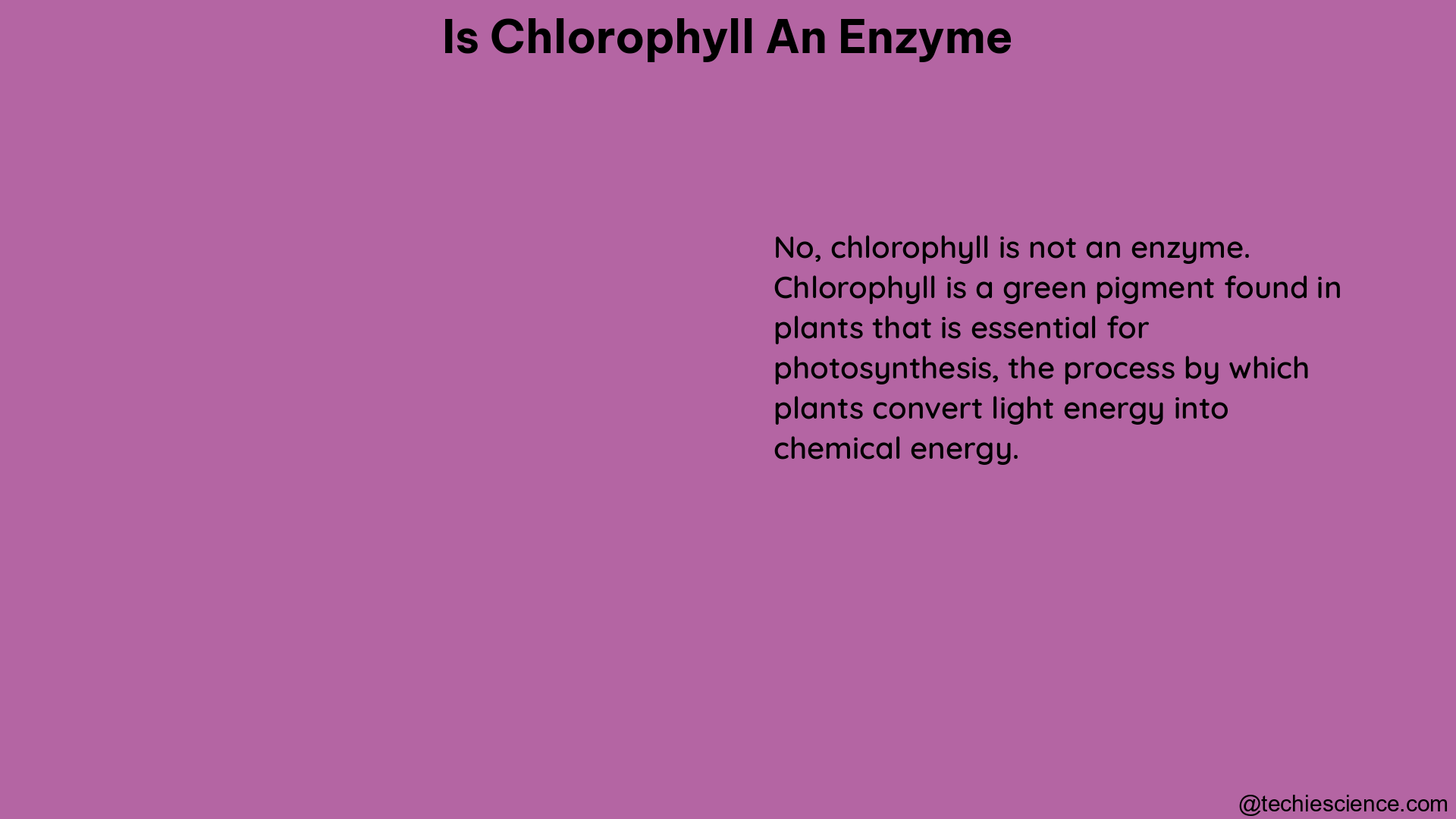Chlorophyll, the green pigment found in plants, is a crucial component of the photosynthetic process, but it is not an enzyme. Enzymes are biological catalysts that accelerate chemical reactions, while chlorophyll is a molecule responsible for absorbing light energy and initiating the photosynthetic pathway. In this comprehensive blog post, we will delve into the intricate details of chlorophyll and its relationship with enzymes, providing a valuable resource for biology students and enthusiasts.
Understanding Chlorophyll
Chlorophyll is a complex organic compound composed of a central magnesium ion surrounded by a tetrapyrrole ring structure. This unique molecular structure allows chlorophyll to absorb specific wavelengths of light, primarily in the blue and red regions of the visible spectrum, which are essential for photosynthesis.
Chlorophyll Structures and Subtypes
There are several subtypes of chlorophyll, each with slightly different molecular structures:
- Chlorophyll a: The most abundant form of chlorophyll, found in all photosynthetic organisms, including cyanobacteria, algae, and plants.
- Chlorophyll b: Found in green plants and some algae, it plays a complementary role to chlorophyll a in light absorption.
- Chlorophyll c: Primarily found in certain types of algae, such as diatoms and dinoflagellates.
- Chlorophyll d: Discovered in some cyanobacteria, it can absorb far-red light, extending the range of wavelengths that can be utilized for photosynthesis.
These chlorophyll subtypes have minor variations in their side chains and central metal ions, which can affect their light-absorbing properties and their roles within the photosynthetic apparatus.
Chlorophyll’s Role in Photosynthesis
Chlorophyll is the central player in the light-dependent reactions of photosynthesis, where it absorbs light energy and transfers it to the photosynthetic reaction centers. This process initiates a series of electron transfer reactions that ultimately result in the production of ATP and the reduction of NADP+ to NADPH, which are essential for the subsequent light-independent reactions (Calvin cycle) of photosynthesis.
Chlorophyllase: The Enzyme Responsible for Chlorophyll Regulation

While chlorophyll itself is not an enzyme, there is an enzyme called chlorophyllase that plays a crucial role in the regulation of chlorophyll levels within plants and photosynthetic organisms.
Chlorophyllase: Structure and Function
Chlorophyllase is an enzyme that catalyzes the removal of the phytol group from the chlorophyll molecule, resulting in the formation of chlorophyllide. This enzymatic reaction is essential for the biosynthesis and degradation of chlorophyll, allowing plants to control their chlorophyll content in response to various environmental and developmental cues.
The structure of chlorophyllase consists of a catalytic domain and a substrate-binding domain, which work together to facilitate the removal of the phytol group from chlorophyll. The specific amino acid residues within the active site of chlorophyllase are responsible for binding to the chlorophyll substrate and positioning it for the catalytic reaction.
Regulation of Chlorophyll Levels
Chlorophyllase plays a crucial role in the regulation of chlorophyll levels within plants. During periods of active growth and development, chlorophyllase activity is typically low, allowing chlorophyll levels to remain high and support the plant’s photosynthetic capacity. However, during senescence or stress conditions, chlorophyllase activity increases, leading to the degradation of chlorophyll and the characteristic yellowing or browning of leaves.
The regulation of chlorophyllase activity is controlled by various factors, including plant hormones, light, temperature, and nutrient availability. For example, the plant hormone ethylene can stimulate chlorophyllase activity, leading to the breakdown of chlorophyll and the onset of leaf senescence.
Chlorophyll vs. Enzymes: Key Differences
While chlorophyll and enzymes are both essential components of biological systems, they have distinct roles and characteristics:
- Function: Chlorophyll is a pigment responsible for absorbing light energy and initiating the photosynthetic process, while enzymes are biological catalysts that accelerate chemical reactions.
- Structure: Chlorophyll has a tetrapyrrole ring structure with a central magnesium ion, while enzymes are complex proteins with specific three-dimensional structures.
- Catalytic Activity: Enzymes possess the ability to catalyze chemical reactions by lowering the activation energy required for the reaction to occur, whereas chlorophyll does not have this catalytic function.
- Regulation: Enzymes can be regulated through various mechanisms, such as allosteric regulation, covalent modification, and changes in enzyme concentration. Chlorophyll levels, on the other hand, are primarily regulated by the enzyme chlorophyllase.
Conclusion
In summary, chlorophyll is a crucial pigment involved in the photosynthetic process, but it is not an enzyme. Enzymes are biological catalysts that accelerate chemical reactions, while chlorophyll is responsible for absorbing light energy and initiating the light-dependent reactions of photosynthesis. The enzyme chlorophyllase, however, plays a vital role in the regulation of chlorophyll levels within plants and photosynthetic organisms.
By understanding the distinct roles and characteristics of chlorophyll and enzymes, biology students and enthusiasts can gain a deeper appreciation for the intricate mechanisms that underlie the fundamental processes of life.
References:
- Tanaka, R., & Tanaka, A. (2011). Chlorophyll cycle regulates the construction and destruction of the light-harvesting complexes. Biochimica et Biophysica Acta (BBA)-Bioenergetics, 1807(8), 968-976.
- Hörtensteiner, S. (2006). Chlorophyll degradation during senescence. Annual review of plant biology, 57, 55-77.
- Schenk, N., Schelbert, S., Kanwischer, M., Goldschmidt, E. E., Dörmann, P., & Hörtensteiner, S. (2007). The chlorophyllase AtCLH1 from Arabidopsis thaliana is a chlorophyll-hydrolyzing enzyme. Plant and Cell Physiology, 48(12), 1704-1709.
- Eckhardt, U., Grimm, B., & Hörtensteiner, S. (2004). Recent advances in chlorophyll biosynthesis and breakdown in higher plants. Plant Molecular Biology, 56(1), 1-14.
- Rüdiger, W. (1997). Chlorophyll metabolism: from outer space down to the molecular level. Phytochemistry, 46(7), 1151-1167.
I am Ankita Chattopadhyay from Kharagpur. I have completed my B. Tech in Biotechnology from Amity University Kolkata. I am a Subject Matter Expert in Biotechnology. I have been keen in writing articles and also interested in Literature with having my writing published in a Biotech website and a book respectively. Along with these, I am also a Hodophile, a Cinephile and a foodie.